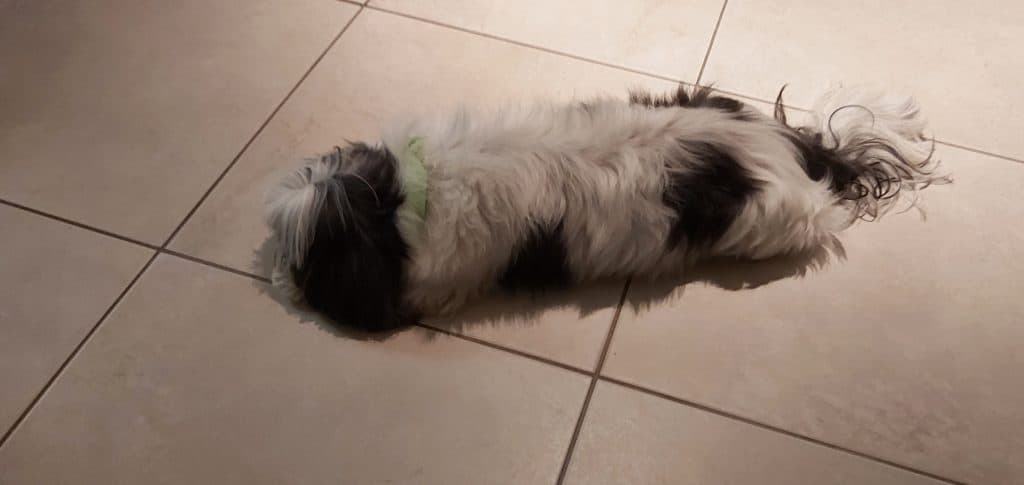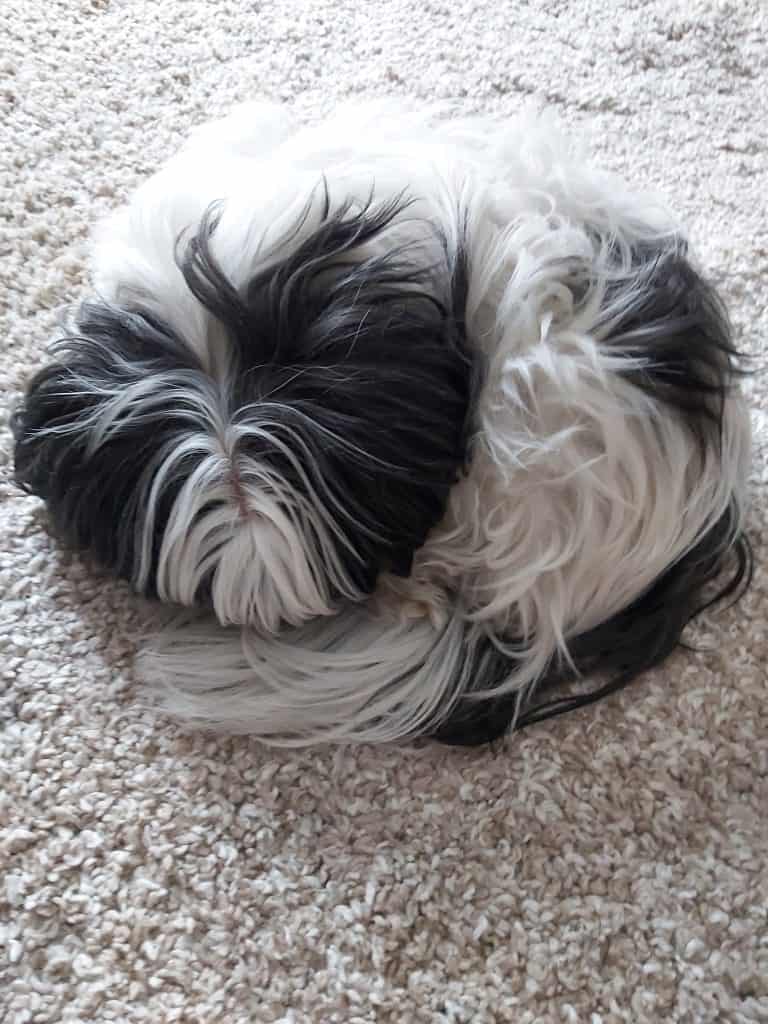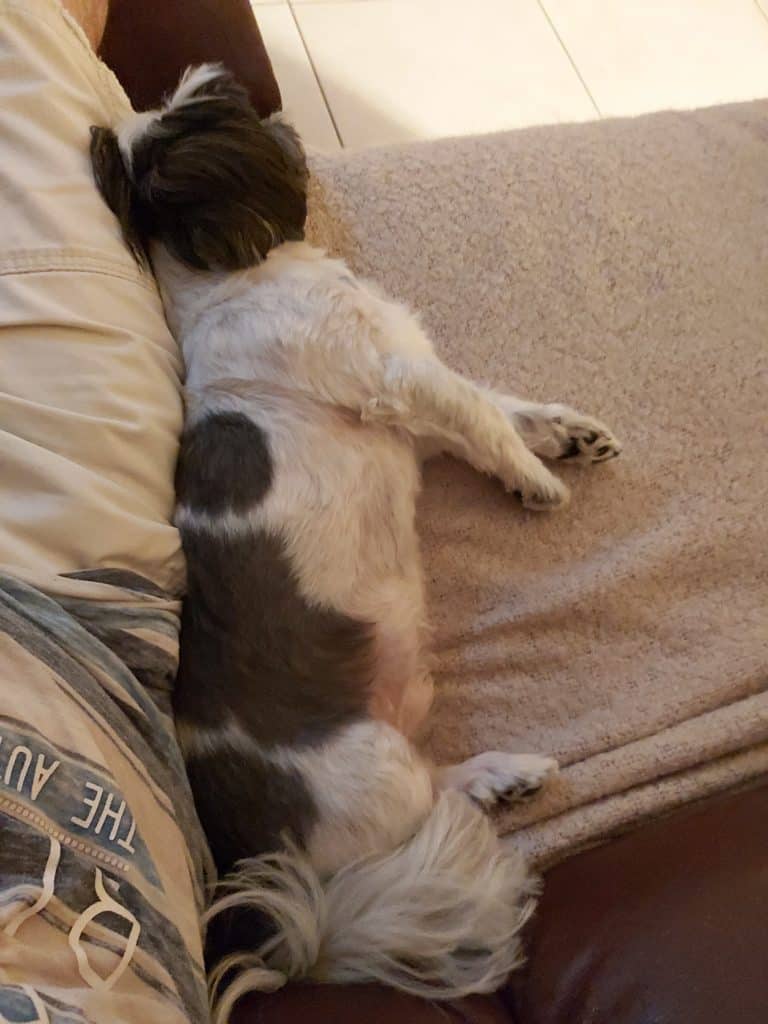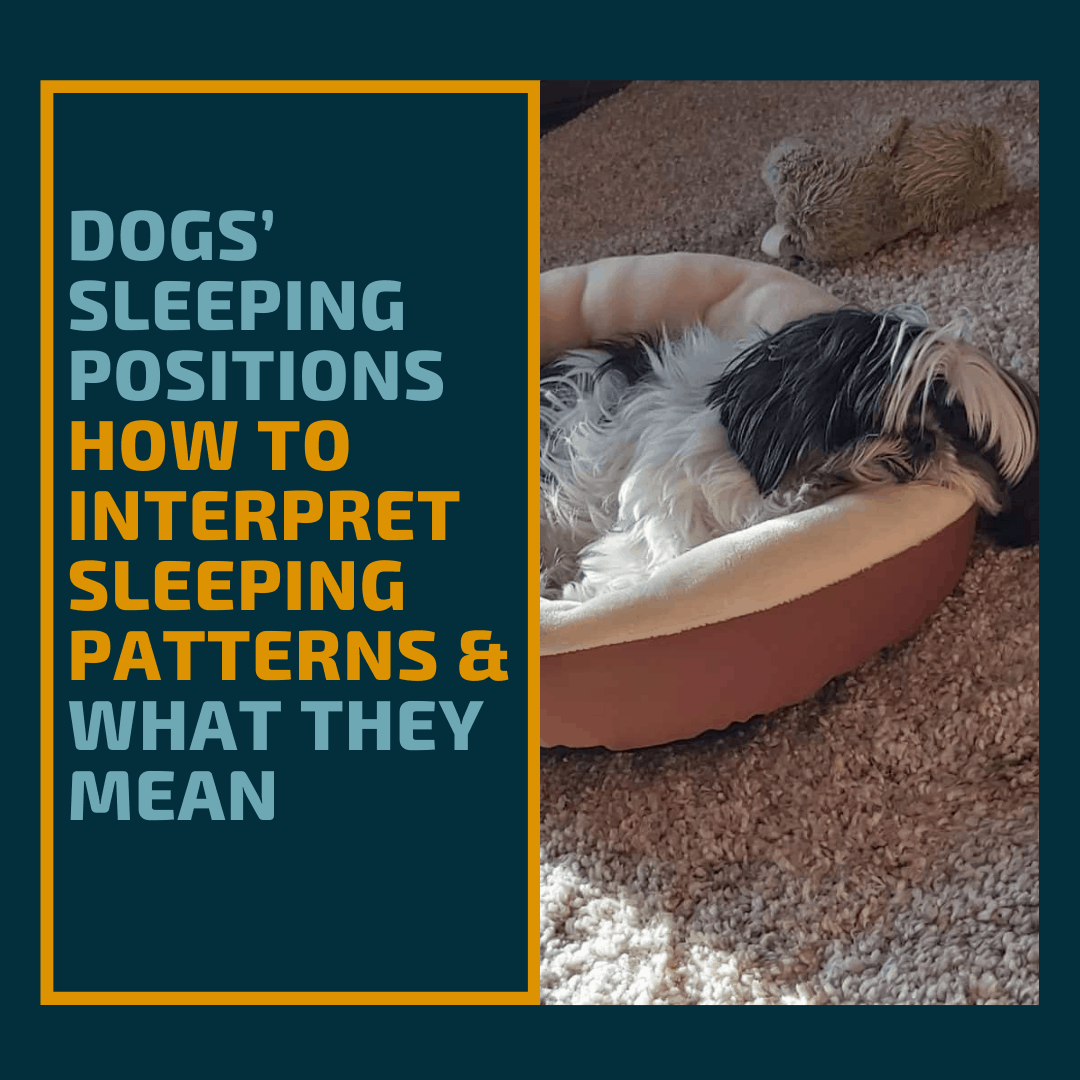Dogs, like people, have various sleeping positions. Dogs will twitch or move around in their sleep and nap for multiple lengths throughout the day. Restlessness often indicates either anxiety or boredom; the breathing pattern may be indicative of stress.
The position your dog takes at night can also reveal how he’s feeling during the day.
A dog’s sleeping habits can give you clues about his health and happiness- if you know how to interpret them.
It is essential to make sure that your dog still sleeps well even if they are getting older. If you notice unusual changes in their sleeping habits, take them to get a checkup with a vet right away.
If you notice a specific behavior while your dog is sleeping, this can indicate one of few possible causes.

Dogs’ Sleeping Positions
Whenever you are at home, watch where your dog sleeps for a few nights. Dogs’ favorite sleeping positions can change based on the location they’re in, who they’re near, or how they feel.
If you notice your dog’s sleeping position changing, it may be a sign that he has an injury or soreness.
Contact your vet as soon as you notice anything out of the ordinary.
The following are common dogs sleeping positions and what they might mean.
The Side Sleeper
If a dog sleeps on its side, it must be feeling pretty safe and comfortable; this position leaves them vulnerable.
Dogs who like to sleep in a lying position are usually pretty relaxed and easygoing.
Sometimes they will change their sleeping position if they’re somewhere unusual or around someone new.
Dogs will also twitch and kick while lying on their side.
The Curler

Dogs commonly sleep curled up in a ball, with their nose to the base of their tail.
It’s a position that is also common among animals in the wild for protection, warmth conservation, and quick access to get up.
Sleeping in a ball restricts movement, so you may not see as much twitching from dogs who sleep this way.
A dog that sleeps in this position might look uncomfortable, but it’s not always the case.
The tuck position is a typical posture for dogs in colder months when chilled or prefers that position.
The Superman position
This position allows a dog to pop up and be on its paws right away with minimal movement.
Think of this position as the sleepover place for puppies who need to nap constantly but want to play when needed.
The play position of choice for high-energy pups or tired dogs is lying flat on their stomach.
Dogs who sleep in this position don’t want to miss an opportunity for adventure, even while taking a nap.
On Their Back, Paws Up
One of the ways dogs cool down is by losing heat through their skin.
They do this by exposing their underbelly, which has a higher chance of evaporating sweat from the body, thus cooling the dog’s whole body off.
The fur around the dog’s belly is thin, and the paws hold their sweat glands, so exposing them to help relieve heat is a helpful strategy.
Dogs use this position to show their submission, and it’s a great way they show how comfortable they are with you.
A pup who sleeps in this position most likely has nothing in his surrounding to worry about.
It’s common during the summer months.
Back-To-Back Or Cuddling

You might find your dog sleeping next to or cuddling with other pets, such as cats, and sometimes snuggling up to you.
Your dog is probably trying to show that they want to get closer or bond with you.
When a dog is this comfortable, it is very loving and affectionate.
Cuddling with and napping next to a dog can be a way of showing your love.
Dogs Sleeping Behaviors
Once your dog is napping, you may get some clues about the quality of their sleep from their behavior.
One of the most critical stages of sleep is REM, which is when the body heals and repairs itself.
It would help if you watched out for these signs that your dog is getting the best sleep possible.
A dog who is experiencing REMS may twitch their paws, tremble or vocalize.
Rapid eye movement (REM) sleep is a lucid phase of sleep characterized by the rapid, random movement of the eyes accompanied by low muscle tone throughout the body. This type of sleep is unique to mammals and large birds.
Circling And Digging
Along with circling before lying down, dogs sometimes dig as they circle their sleeping area, which is normal behavior.
Dogs’ habits from their ancestral furrier cousins who often trampled down grass, leaves, or snow are likely the source of this behavior.
They might also dig as a way to stay warm on winter days or enjoy cooling around in summer heat.
Dogs circle before they lie down because they are marking their territory. They also use that process to find a good spot in the house or yard where it’s comfortable enough for them to sleep at night.
A dog who is circling and digging might be trying to do one of two things:
- The first possibility is that your pup is looking for an area with softer soil, as this can provide more comfort when sleeping on rocks or hard ground.
- The second possible explanation for circling behavior may be the desire to create a place large enough so that no other animals will try and take over his space while he sleeps!
It’s all about the bed
If you’ve been providing your four-legged friend with plenty of bedding, there should not be any need for him to make any circles.
He may be itching. If he has allergies or allergy-prone skin, this could make his itchiness worse at night time and the scratching will cause him to rotate positions while sleeping in order to reach all parts of their body for relief.
Watch your dog’s behavior during a nap if you’re concerned they might not be getting enough sleep or are uncomfortable after waking up from a snooze.
This way, you’ll know if it’s just something that happens occasionally (which is very common) versus them having some sort of condition like arthritis where they need more restful sleep position options.
There is no one size fits all solution when it comes to picking the perfect bed! In most cases though, your dog will prefer a bed that most closely resembles their sleeping position.
Some dogs may sleep in positions which can pose problems for them if they are older, injured, or have arthritis so it’s important to take note of what type of sleeping arrangements work best for the individual animal.
A dog with some condition like arthritis would need to lay down on an incline rather than a flat surface.
The same goes for senior dogs because this could help alleviate any medical symptoms such as pain and swelling.
Light Snooze
For light dozing, the dog will often be lying on its side but with a more organized body position.
This is usually seen in dogs who are older or have some injuries. Dogs may also sleep like this if they are recovering from surgery and can’t lay down flat because of it.
This sleeping position gives less support to their joints so it might not work for long periods at night.
Carefully monitor your dog if they perk up their ears when there’s movement or noise. This means that your canine is still feeling fairly alert and looking for something.
You might want to do something more fun as an alternative, like taking a walk or playing fetch.
Twitching and Tail-Wagging
When watching a dog’s tail, you’ll notice that they will twitch and wag slightly while sleeping.
This is often the most active part of their sleep cycle as it gives them some sort of rest without actually waking up completely for more than a few seconds at a time.
It may mean your canine has had an exciting day prior to this or just needs something different in order to feel refreshed once again.
If your dog was fairly energetic before going to bed, then try providing distractions like toys or chew bones with food inside. They might find something else to do other than eat themselves out of boredom.
Dogs often move around in their sleep. They could be dreaming, but even so, they are getting a deep and refreshing night’s sleep.
Twitching, tail wagging, and leg kicks are common during this stage of sleep. It’s preferable to let sleeping dogs lie at this time because the restorative steps are beneficial for their health.
Puppies move more frequently than older dogs when sleeping, but no one can pinpoint the reason.
When dogs feel cold, they sometimes put off heat by shaking and twitching. The twitches are their body’s way of warming up to get it warm again.
In that case, cover them up with a blanket or put them into bed with another pet who gives off some heat.
If your dog seems to suffer from cold sometimes, it may be a good idea to invest in a self-warming dog bed.
Signs Of Discomfort
If your dog is unusually agitated during sleep, try using these soothing techniques:
- Call their name softly.
- Stroke their back or side in calming motions.
- Offer words of comfort with a calm tone.
Pups may wake up with a renewed sense of comfort or continue to sleep after you comfort them.
If you know your dog’s usual sleeping habits, you could tell when something is unusual.
When in doubt about your dog’s behavior, observe its regular sleeping habits to make an assessment.
It’s worth scheduling a veterinarian visit if you notice that your pet often has trouble sleeping and appears agitated.
To Wrap Up
What’s your dog’s favorite sleep position? Is it one of the ones we listed in this blog post, or is it a new and different one that they invented all on their own?
Dogs are such creatures of habit. We know ours has his preferred positions, but he also likes to switch up if he feels like he needs more room for some reason (in the house!).
There can be anxiety triggers associated with not feeling comfortable so make sure your pup gets plenty of restful sleep by providing them with a soft, cozy bed.
If you enjoyed this post on Dogs Sleeping Positions: How to Interpret Sleeping Patterns and What They Mean please share it with your friends or family!
References: Rapid eye movement sleep – Wikipedia.
Recent Posts
As a dog owner, you want to ensure that you take proper care of your furry companion. A common question that many pet owners have is, "Can I walk my dog 30 minutes after eating?" Understanding the...
Have you ever considered getting an elevated dog bed for your furry friend, but wondered if it's worth the investment? If so, you're not alone. As dog owners, we all want to provide the best care for...

